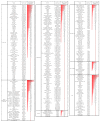Optimizing Crop Production with Bacterial Inputs: Insights into Chemical Dialogue between Sphingomonas sediminicola and Pisum sativum
- PMID: 37513019
- PMCID: PMC10385058
- DOI: 10.3390/microorganisms11071847
Optimizing Crop Production with Bacterial Inputs: Insights into Chemical Dialogue between Sphingomonas sediminicola and Pisum sativum
Abstract
The use of biological inputs is an interesting approach to optimize crop production and reduce the use of chemical inputs. Understanding the chemical communication between bacteria and plants is critical to optimizing this approach. Recently, we have shown that Sphingomonas (S.) sediminicola can improve both nitrogen supply and yield in pea. Here, we used biochemical methods and untargeted metabolomics to investigate the chemical dialog between S. sediminicola and pea. We also evaluated the metabolic capacities of S. sediminicola by metabolic profiling. Our results showed that peas release a wide range of hexoses, organic acids, and amino acids during their development, which can generally recruit and select fast-growing organisms. In the presence of S. sediminicola, a more specific pattern of these molecules took place, gradually adapting to the metabolic capabilities of the bacterium, especially for pentoses and flavonoids. In turn, S. sediminicola is able to produce several compounds involved in cell differentiation, biofilm formation, and quorum sensing to shape its environment, as well as several molecules that stimulate pea growth and plant defense mechanisms.
Keywords: Sphingomonas sediminicola; molecular dialogue plant–bacteria; pea; plant–bacteria interaction; root exudates.
Conflict of interest statement
The authors declare no conflict of interest.
Figures



Similar articles
-
Sphingomonas sediminicola Dae20 Is a Highly Promising Beneficial Bacteria for Crop Biostimulation Due to Its Positive Effects on Plant Growth and Development.Microorganisms. 2023 Aug 11;11(8):2061. doi: 10.3390/microorganisms11082061. Microorganisms. 2023. PMID: 37630621 Free PMC article.
-
Sphingomonas sediminicola Is an Endosymbiotic Bacterium Able to Induce the Formation of Root Nodules in Pea (Pisum sativum L.) and to Enhance Plant Biomass Production.Microorganisms. 2023 Jan 12;11(1):199. doi: 10.3390/microorganisms11010199. Microorganisms. 2023. PMID: 36677491 Free PMC article.
-
Heat stress tolerance in peas (Pisum sativum L.): Current status and way forward.Front Plant Sci. 2023 Jan 17;13:1108276. doi: 10.3389/fpls.2022.1108276. eCollection 2022. Front Plant Sci. 2023. PMID: 36733601 Free PMC article. Review.
-
Wild pea (Pisum sativum L. subsp. elatius (Bieb.) Aschers. et Graebn. s.l.) at the periphery of its range: Zagros Mountains.Vavilovskii Zhurnal Genet Selektsii. 2020 Feb;24(1):60-68. doi: 10.18699/VJ20.596. Vavilovskii Zhurnal Genet Selektsii. 2020. PMID: 33659782 Free PMC article.
-
A fine-tuned defense at the pea root caps: Involvement of border cells and arabinogalactan proteins against soilborne diseases.Front Plant Sci. 2023 Feb 9;14:1132132. doi: 10.3389/fpls.2023.1132132. eCollection 2023. Front Plant Sci. 2023. PMID: 36844081 Free PMC article. Review.
Cited by
-
Decrease in beneficial bacteria and increase in harmful bacteria in Gastrodia seedlings and their surrounding soil are mainly responsible for degradation of Gastrodia asexual propagation.Front Plant Sci. 2024 Feb 6;15:1334958. doi: 10.3389/fpls.2024.1334958. eCollection 2024. Front Plant Sci. 2024. PMID: 38379940 Free PMC article.
-
Sphingomonas sediminicola Dae20 Is a Highly Promising Beneficial Bacteria for Crop Biostimulation Due to Its Positive Effects on Plant Growth and Development.Microorganisms. 2023 Aug 11;11(8):2061. doi: 10.3390/microorganisms11082061. Microorganisms. 2023. PMID: 37630621 Free PMC article.
References
-
- Kumari B., Mallick M.A., Solanki M.K., Solanki A.C., Hora A., Guo W. Plant Growth Promoting Rhizobacteria (PGPR): Modern Prospects for Sustainable Agriculture. In: Ansari R.A., Mahmood I., editors. Plant Health Under Biotic Stress. Springer; Singapore: 2019. pp. 109–127. Volume 2: Microbial Interactions.
-
- Oleńska E., Małek W., Wójcik M., Swiecicka I., Thijs S., Vangronsveld J. Beneficial Features of Plant Growth-Promoting Rhizobacteria for Improving Plant Growth and Health in Challenging Conditions: A Methodical Review. Sci. Total Environ. 2020;743:140682. doi: 10.1016/j.scitotenv.2020.140682. - DOI - PubMed
-
- Khan A.L., Waqas M., Kang S.-M., Al-Harrasi A., Hussain J., Al-Rawahi A., Al-Khiziri S., Ullah I., Ali L., Jung H.-Y., et al. Bacterial Endophyte Sphingomonas Sp. LK11 Produces Gibberellins and IAA and Promotes Tomato Plant Growth. J. Microbiol. 2014;52:689–695. doi: 10.1007/s12275-014-4002-7. - DOI - PubMed
-
- Etesami H., Adl S.M. Plant Growth-Promoting Rhizobacteria (PGPR) and Their Action Mechanisms in Availability of Nutrients to Plants. In: Kumar M., Kumar V., Prasad R., editors. Phyto-Microbiome in Stress Regulation. Springer; Singapore: 2020. pp. 147–203. Environmental and Microbial Biotechnology.
Grants and funding
LinkOut - more resources
Full Text Sources
Molecular Biology Databases

